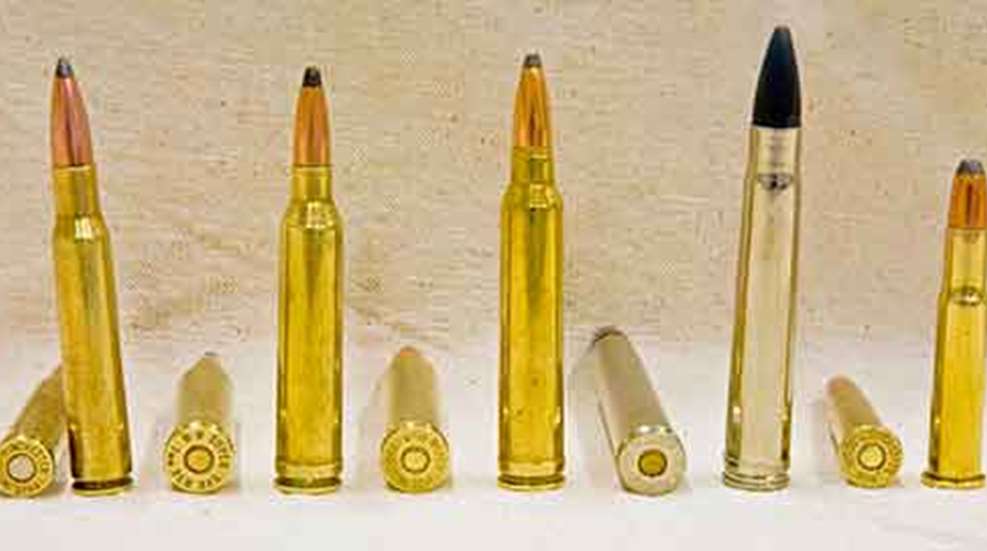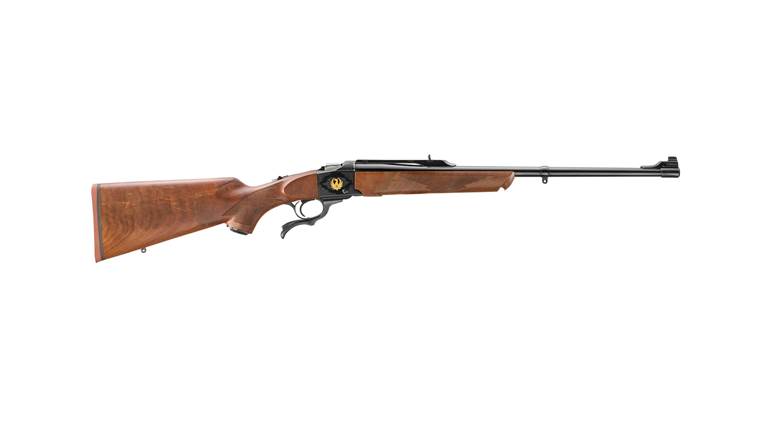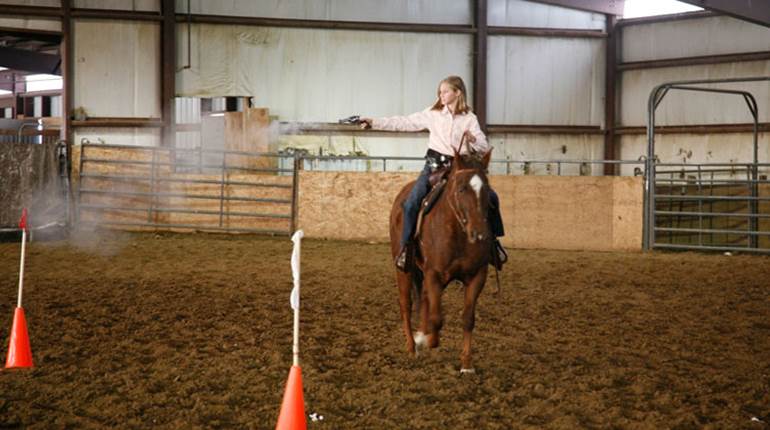
Aficionados of sporting rifles detest the notion of one rifle that can do virtually everything. We love rifles, and the more, the better. But there are those who cannot afford or don’t want a gaggle of rifles to take care of. They value simplicity and versatility, and often they like to say, “Beware the man with one gun. He probably knows how to use it.” Here’s a look at five of the most popular all-around cartridges with some mentions of their not-so-popular ballistic twins.
The .30-06 Springfield
The 108-year-old .30-06 Sprg. is without a doubt the king of all-around cartridges. It has been chambered in every rifle action ever designed, from single-shot to semi-automatic-even machine guns. Of military heritage, the .30-06 was the culmination of an effort to outdo the 7x57 mm Mauser that stung U.S. troops so badly during the Spanish-American War. The initial offspring-the .30-03-featured a 220-gr. round-nose bullet at 2400 fps. It had thump but not range. Three years later came the .30-06 with a 150-gr. bullet at 2900 f.p.s. Two world wars plus the Korean conflict gave several generations of soldiers and hunters a decisive performance record for the cartridge. In short, it works very well on varmints up through big game.
With 110- to 125-gr. bullets at 3200 f.p.s the .30-06 Sprg will hold its own against .22- and .24-cal. varmint rigs. Sure the dedicated varminter will perform better, especially at long range, but Mr. One Rifle won’t need to pack up his gear and wait in the truck. The 150- to 180-grainers is where this cartridge shines, and as long as you choose your bullets wisely and do your part as a shooter, the .30-06 Sprg. will handle any deer, antelope, elk or moose you care to tangle with. Bullets from 200 to 250 grains in the .30 caliber will thump hard-on both ends-but they’ll also get the job done. Longtime friend and rifle scribe Sam Fadala took a Cape buffalo with a 220-gr., .30-06, and he did so with just one shot.
The .30-06 Sprg. has been necked down to .22 caliber and necked up to .400. Ballistic twins-in terms of practicality-the .270 Win. and .280 Rem. can do just about what their pappy can. The .270 shoots a bit flatter, as does the .280, but I rather doubt there is a creature on earth that could tell the difference once hit with any of these cartridges.
7 mm Remington Magnum
Introduced 52 years ago along with the Remington 700 rifle, the 7 mm Rem. Mag. has muscled itself into the all-around cartridge tribe. The intention was to provide a cartridge that shoots flatter and hits harder than the .30-06 Sprg. and still keep recoil manageable. Bullet weights for handloaders range from the 110-grain Barnes TTSX to 190-grain Bergers. With a Barnes 110-gr. TTSX loaded to 3500 fps you can keep the marmots at bay. The 140- to 190-gr. at from 2860 to 3110 f.p.s. are the bread-and-butter bullets for most American big-game hunters. Deer, pronghorn, elk and moose are all fair game for Big Green’s Big 7.
In order to achieve those ballistics, however, the 7 mm Rem. Mag. needs a long enough barrel-26” or even 28”. Shorter and more common 24” barrels give up enough velocity and make the Big 7 a sort of loud .270 Win. on a belted case. Usually the sophisticated 7 mm Mag shooter has a custom rifle made with a longer barrel to take full advantage of the cartridge and its capabilities. Many 7 mm Mag aficionados prefer it because it provides true magnum performance with less recoil that the .300 Win. Mag.
Attempts have been made to “magnum” the 7 mm Remington Magnum-most notably the 7 mm STW and 7 mm Remington Ultra Mag-but none have been able to unseat the Big 7 from its perch as one of the great and most popular all-around cartridges. For the hair splitters, the .30 calibers tend to be slightly more accurate than the 7 mm because more effort has been put forth-especially via target shooters-to make more accurate bullets. That said, there are some custom 7s out there that can shoot rings around most of the .30s.
.300 Win. Mag.
Though neither the first .30-cal. magnum, nor the most powerful one, the .300 Win. Mag. has earned a place in the hearts of many big-game hunters worldwide. Like its older brothers-the .264, .338 and .458 Winchester Magnums-the .300 Win. is one of the first short magnums. All three cartridges came from the .375 H&H Mag. shortened so that they would fit in a standard .30-06-Sprg.-length bolt-action rifle. It offers about 9 percent more velocity than the .30-06 but nearly 30 percent more energy at the muzzle.
The .300 Win. Mag. quickly garnered a reputation as a fine deer and elk cartridge, especially out in the west where shots tend to be longer. Initially it also had a reputation as a hard-kicking and difficult to handle rifle. However, once shooters demanded a better stock design with a straight comb and little drop at the heel and they learned how to control it, the .300 Win. Mag.’s popularity soared. It is now one of the go-to cartridges for long-range sniping and 1,000-yard target shooting in addition to its longtime popularity with hunters. It is a top choice for plains game in Africa and a great choice for bear, whether black, brown or grizzly.
It gets some grief from handloaders because of its short neck, but most hunters don’t mind because of its performance in the field. Ballistic theoreticians dissed the short neck as an impediment for accuracy, but, again, the fact that the .300 Win. Mag. delivers the goods for long-range hunters, snipers and on the target range pretty well dismisses that argument.
.375 Holland & Holland Magnum
There may not be quite as many .375 H&H Magnums lounging in the racks of pickup trucks as there are .30-06s, but worldwide the cartridge remains one of the most popular ones of all time-and rightly so. Its trajectory is as flat as a .30-06, but it delivers 40 percent more energy to the target. That might not seem so big a deal if all you are shooting are antelope and deer, but if the target can either bite or stomp you back that increase in energy can be a lifesaver.
The .375 H&H Mag. is usually loaded with bullets from 200 to 300 grains, with the 235- to 270-grainers most popular. As with all of these cartridges, ammunition is usually available anywhere in the world where it is sold. In terms of need, unless you are hunting one of the larger bears-grizz or brown-the .375 H&H Mag. isn’t really needed. However, when one’s hunting adventures take them abroad and big cats or buffalo are on the menu most hunters want all the edge they can get. The .375 is one of the most popular stopper or backup rifles used by guides and professional hunters.
In rifles with well-designed stocks recoil-which many have reported as vicious in order to puff up their own egos-is quite manageable. I would probably not want to spend a day shooting prairie dogs with a .375, nor would I want a .223 Rem. in my hands if facing a Cape buffalo. On my first safari I took only a .375 and used it on everything from 140-lb. impalas to a 2,000-lb. eland. I’d call that an all-around cartridge.
Winchester Center Fire (WCF)
To round out our top five all-around sporting cartridges I chose one that has been more than just popular for 119 years. This cartridge was initially in a lever-action rifle and remains virtually synonymous with that rifle platform. Yet it, too, has been chambered in bolt actions, single shots and even drillings. A rimless version-the .30 Remington-has seen service in pump and semi-automatic rifles as well. Like the other cartridges examined here, it has been used worldwide from rabbits to elephants and pretty much everything in between. I am referring, of course, to the .30-30 Winchester Center Fire (WCF).
Often cited as the first smokeless powder cartridge, the .30-30 was actually predated a few months by its smaller sibling the .25-35 WCF. But the .30 caliber outshone the older sibling in spades. More than 7 million Model 94 Winchester rifles have been made, and the vast majority were chambered in .30-30. Other lever actions such as the Savage 99 and Mossberg’s Model 464, have been chambered for this round. Savage also made a couple of bolt actions in .30-30, the models 325 and 340.
The cartridge has been used for everything from bunnies to moose and walrus. Though sniffed at and disdained by many modern riflemen, the .30-30 is still plenty of gun for most big game when used within its 200 yard limitation. I have a cast-bullet load featuring the RCBS 150-gr. flat point in front of 15 grains of IMR Trail Boss that will consistently take the eye out of a cottontail at 25 yards. Noise and recoil is nil.
So there you have it; my five top all-around sporting cartridges. As a collector and user of rifles I’d hate to be limited to just one. But for those who prefer to be the one-gun man, any of these cartridges would serve you very well.





































